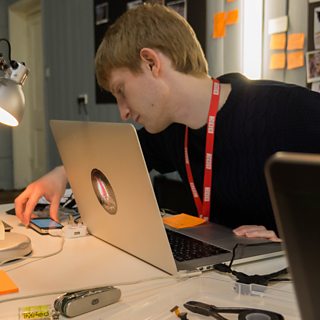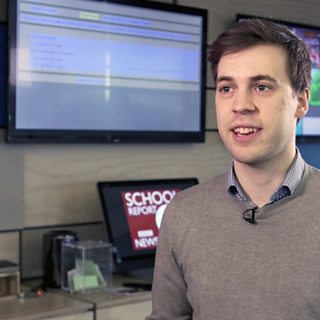
Each September , beginning a two year programme of on-the-job training, project work and courses. This year, we challenged our new recruits to spend their first two weeks designing and developing a novel way of accessing Βι¶ΉΤΌΕΔ content using the Oculus Rift virtual reality headset.
Take a look as 2013 Trainee, , talks you through what they created:
A few weeks ago, we welcomed and (Trainee Research Scientists) as well as , and (Trainee Research Technologists) to the department. Our five new recruits were asked to spend their first two weeks working with the virtual reality headset, with a brief to develop an immersive 'information browser' for Βι¶ΉΤΌΕΔ content.
The Rift headset features a binocular stereoscopic display and an accurate, low-latency head tracker. Whilst Rift-like devices are typically used for gaming, computer aided design and simulation activities, we wanted our trainees to try something different: Using the Rift to present a 3D information browser, capable of visualising content.
User Centered Design
Lianne and Rhianne worked to ensure the development of the prototype was user focused from the outset: Designing an intuitive interaction model and feeding a large amount of background research into the project.
We are calling the prototype which has emerged from this process 'NewsWorld'. In NewsWorld, the user appears to be standing in the center of a photorealistic globe, with news stories placed appropriately over their corresponding geographic area. Articles can be selected using head gestures and mouse buttons are then used to 'drill down' deeper into content as desired.
The trainees in action
Technical Architecture
Sam, Tom and Pete divided the tasks required to realise the design into three major areas:
- Content acquisition: How to obtain news articles with which to populate NewsWorld
- Graphics renderer: Written in C++ and using Qt
- Interfacing between the content acquirer and a graphics renderer
Sam looked at the first of these tasks, deciding to make use of the Βι¶ΉΤΌΕΔ News RSS feeds to acquire content. He built an RSS and XML parser in Python, which also performed a detailed geo-location of each article and determined relationships between similar stories.
Tom developed a C++ renderer for NewsWorld. This positioned the user's virtual camera within a sphere and plotted news articles. A three tier navigation model was created, with users using left and right mouse clicks to traverse between layers:
- Layer 1 shows a view of the world with 'pins' located at locations with news articles
- Layer 2 shows the set of news articles at each location, represented by photos.
- Layer 3 shows summary text about a specifically selected article, alongside more photos.
Meanwhile, Pete was busy developing a WebSocket interface between Sam's Python content acquirer and Tom's C++/Qt renderer. This meant defining a common interface between the Python and C++ world, which was achieved using JSON data representation and the parser for C++
End Result ...And Where Next?
The end result of this project is a robust and flexible framework for displaying geographic content on the Oculus Rift. Furthermore, our trainees gained some useful experience developing software in a collaborative, user-driven and agile manner.
To properly conclude the work, Lianne and Rhianne developed a user research experiment to evaluate how individuals responded to browsing content using the prototype. The results of this showed that users generally found the experience positive and enjoyable, though there was a desire to be able to drill even deeper into stories and to access richer content such as video. Users were also concerned with the constraining nature of the wires used to connect the Rift to a computer and the lack of accommodation for those who need prescription glasses.
All five trainees also took part in a presentation of their work to staff in R&D North Lab, which provided a great opportunity to showcase their achievements, and also provoked some interesting debate around the creation of shared social immersive experiences using multiple Rifts.
A user experiences 'NewsWorld'
As for where we go next with this project, we have begun to identify other Βι¶ΉΤΌΕΔ content areas which would work well with the NewsWorld framework. We are intending that an installation based around NewsWorld will be used at one of several public Βι¶ΉΤΌΕΔ events in the near future, providing a unique way of immersing users in our output and a novel content discovery mechanism.
I am extremely impressed with the quality of work produced by our trainees this year, as well as their readiness to learn new skills, excellent team-working, and overall professional approach to the project. Finally I would like to thank Βι¶ΉΤΌΕΔ R&D's , , and for their help and support in making this project the success it was.
Lianne facilitates a user research session
- -
- Profiles of our intake of trainees and graduates from |
- Our graduates on their experience at Βι¶ΉΤΌΕΔ R&D One Year On -
- See what our trainees did for their introduction to Βι¶ΉΤΌΕΔ R&D |
- Find out about Βι¶ΉΤΌΕΔ R&D's and


